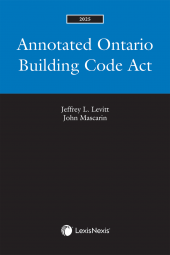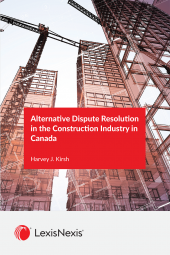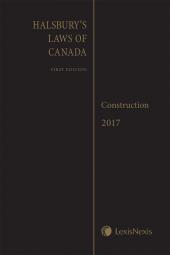The Canadian Law of Architecture and Engineering, 3rd Edition
One Year Subscription Only Terms
Subscribers receive the product(s) listed on the Order Form and any Updates made available during the annual subscription period. Shipping and handling fees are not included in the annual price.
Subscribers are advised of the number of Updates that were made to the particular publication the prior year. The number of Updates may vary due to developments in the law and other publishing issues, but subscribers may use this as a rough estimate of future shipments. Subscribers may call Customer Support at 800-833-9844 for additional information.
Subscribers may cancel this subscription by: calling Customer Support at 800-833-9844; emailing customer.support@lexisnexis.com; or returning the invoice marked 'CANCEL'.
If subscribers cancel within 30 days after the product is ordered or received and return the product at their expense, then they will receive a full credit of the price for the annual subscription.
If subscribers cancel between 31 and 60 days after the invoice date and return the product at their expense, then they will receive a 5/6th credit of the price for the annual subscription. No credit will be given for cancellations more than 60 days after the invoice date. To receive any credit, subscriber must return all product(s) shipped during the year at their expense within the applicable cancellation period listed above.
Détails des produits
As explained in the preface to this new volume, in the more than 25 years since the second edition of The Canadian Law of Architecture and Engineering was published, the practice and law related to architecture and engineering have changed in important ways, including “the increased mobility of architects and engineers within Canada and internationally and the legal requirements imposed on professionals from outside of the country, and the importance of addressing the environmental impact of building projects.” All of these significant changes are addressed in this third edition of The Canadian Law of Architecture and Engineering.
Invaluable insight
Co-authored by Beverley McLachlin, the former Chief Justice of the Supreme Court of Canada, and seasoned lawyer Arthur Grant, The Canadian Law of Architecture and Engineering, 3rd Edition is an essential guide for architects, engineers and those in the construction industry – including their legal advisors – as it examines the legal principles governing the practice of these professions.
Updated to include new and significant judicial decisions as well as legislative and administrative amendments, this latest edition is sure to become an indispensable reference. In addition to revised content, this text provides readers with practical precedents of forms and contracts that they can use as templates, as well as useful tables setting out the applicable professional code of ethics for each province and territory so architects and engineers understand their duties and obligations.
An authoritative resource
Written by renowned authors and featuring up-to-date case law and commentary, this long-awaited third edition of The Canadian Law of Architecture and Engineering would be a smart acquisition for:
- Architects who need a resource to help them understand the laws and regulations that govern their practice
- Engineers who can rely on it for insight into the laws and regulations that govern their profession
- Lawyers who represent clients in the construction, architecture or engineering sectors
- Judges and courts who are looking for a quick reference guide to the laws that govern the architecture and engineering professions
Table des matières
PART I – LEGAL PRINCIPLES
Chapter 1: The Canadian legal system
A. Introduction
B. The common law
C. Statute law
D. The Civil Code of Québec
E. Decisions by administrative bodies
Chapter 2 : Definitions
A. Introduction
B. Definition of architect
C. Definition of engineer
Chapter 3: Qualifying to practise
A. Introduction
B. Qualifications
C. Councils
D. Practising without a license
E. What constitutes the practice of architecture and engineering?
Chapter 4 : Business organization
A. Introduction
B. Requirements with respect to all organizations
C. Sole proprietorship
D. Partnership
E. Incorporation
F. Joint firms
G. Information associations
Chapter 5 : Professional obligations
A. Introduction
B. The basis of our system of professional responsibility
C. Legislation, regulations, by-laws and codes of ethics
D. Specific duties imposed on professionals
E. Complaints and discipline
Chapter 6 : General principles of contract law
A. Introduction
B. Definition
C. Essential elements
D. Problems arising out of the assent process
E. Termination
F. Classification of contracts
G. Damages for breach of contract
Chapter 7 : Relationship to the client
A. Introduction
B. The relationship to the client
C. Form of the contract
D. Content of the contract
E. Duration of the contract
F. Duties of the architect or engineer
G. Duties of the client
Chapter 8 : Authority of the architect or engineer
A. Introduction
B. Legal basis of authority
C. Actual authority
D. Implied authority
E. Rights of the owner when architects or engineers exceed their authority
F. Rights of the contractor when architects or engineers exceed their authority
Chapter 9 : Duties of the architect or engineer to the client
A. Introduction
B. The professional standard of care
C. Preliminary proposals and cost estimates
D. Compliance with federal, provincial and municipal regulations
E. Design
F. Examination of construction site and soil conditions
G. Preparation of drawings, specifications and instructions
H. Supervision
I. Interpretation of specifications and variations to the work
J. Duties respecting certification or stamping of drawings
Chapter 10: Professional liability
A. Introduction
B. Increase in claims against professionals
C. The sources of civil liability – contract, tort and fiduciary duty
D. Claims for breach of contract
E. Claims in tort
F. Breach of fiduciary duty
G. Interrelationship between contract, tort and fiduciary duty
H. Measure of recovery
Chapter 11: Professional liability insurance
A. Introduction
B. Obtaining liability insurance
C. The extent of the coverage
D. Duties and rights of the insured
E. Prevention of claims
Chapter 12: The architect and engineer as decision-maker
A. Introduction
B. Common situations where the architect or engineer acts as a decision-maker
C. The nature of the duty
D. Liability for decisions
Chapter 13: Arbitration proceedings and other forms of dispute resolution
A. Introduction
B. Conciliation
C. Neutral evaluation/Fact-finding
D. Adjudications
E. Mediation
F. Arbitration
G. Special dispute procedures available within the litigation system
Chapter 14: Ownership of drawing, copyright and patent
A. Introduction
B. Ownership of drawings distinguished from ownership of copyright
C. Ownership of the physical drawings and other construction documents
D. Ownership of copyright in plans, specifications and other construction drawings
E. Moral rights
F. Infringement of copyright
G. Assignment or licence
H. Patents
Chapter 15: Remuneration of architects and engineers
A. Basis of the right to remuneration
B. Contracts with express provisions for payment
C. Payment based on a percentage of the cost of the work
D. Reasonable remuneration
E. Drawings on approval
F. Competition drawings
G. Compliance with conditions
H. Incomplete services
I. Additional services
J. When the right to payment arises
K. Recovery of payment
PART II – FORM CONTRACTS
Introduction
No. 1: Canadian Standard Form of Contract for Architectural Services – Document Six, 2018 Edition
No. 2: Engineering agreement between client and engineer
No. 3: Agreement between engineer and sub-consultant
APPENDICES
 Lexis Nexis
Lexis Nexis 


